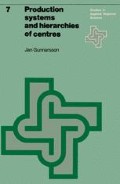Abstract
The subject of this chapter is the formulation of a programming model. The model includes input-output coefficients. Indivisibilities and transportation costs are also taken into consideration. Capacities of plants are given. Consequently, the importance of location choices to the size of plants has not been dealt with. An alternative formulation is put forward in chapter 5, where capacities and spatial dispersion are determined simultaneously. Section 4.3 deals with the model itself, and is followed by a section with some numerical examples testing Tinbergen’s hypothesis. In the first two the optimal structure of the system of centres is compared for different values on the coefficient relating final demand for agriculture to total income. The purpose of the third example is to show the nature of optimum with different spatial distributions of agriculture and other natural resources.
Access this chapter
Tax calculation will be finalised at checkout
Purchases are for personal use only
Preview
Unable to display preview. Download preview PDF.
Notes
Stuart (1975) emphasizes another reason for this phenomenon: When retailers locate next to each other, this is in order to cut down “consumer costs for information about prices, qualities etc.” This produces an effect on the income of consumers that has a favourable influence on retailer profits.
The figure is my own.
A correct measure for the evaluation of economies of scale of cities should be based on (4.2). Generally, evaluations are based on (4.1), which in some cases leads to an overestimation of the productivity of big cities.
Or between the agricultural sector and a centre.
Raw material production is fully comparable to agriculture in this respect.
The condition is not sufficient to reduce transportation costs in the case of a concentration.
Note that (4.9′) and (4.10′) lack magnitudes other than parameters. Serck-Hanssen (1970) uses similar expressions, but the inequalities also contain mangitudes for the outputs of the sectors.
A type of activity widely noticed during recent years is polluting industry. This includes pulp factories, nuclear power plants and the petro-chemical industry, all of which consume great quantities of water. Great supplies of water are therefore necessary for these establishments. In the interest of environment, exploitation of such resources has been concentrated to a small number of locations. These two circumstances have made that polluting industry also comes into the locationally restricted category.
Two known approaches exist. Either Gomory-constraints (E. M. Beale, 1965) or ‘Branch and bound’ (N. Agin, 1966) are used. Only the latter method is of interest here.
If a computer needs one second to calculate the solution of each combination, it would need, in total, 25 days and nights to compute all combinations.
A presentation of OPHELIE MIXTE is found in B. Roy, R. Benayoun, J. Tergny: From SEP procedure to the MIXED OPHELIE (J. Abadie, 1970).
The coefficients in the input-output table of the Swedish Long Term Surveys have been summarized by row according to the classification in table 4.1. The totals have been divided by the number of sectors in the respective aggregate. The coefficients in table 4.1 have therefore been obtained by summarizing by column.
Tinbergen’s hypothesis.
Finances did not permit the realization of such a project.
It may surprise the reader that no agricultural production or Extractive industry is allowed in A. The explanation is that we expected centre A to become the metropolis in this example too, and that we were interested in studying the inflauence of the absence of agriculture in A on the degree of self-sufficiency for the centre.
This assumption is unrealistic, but allows for a certain simplification of the presentation.
This implies that we give up the requirements for equality in (4.13).
Author information
Authors and Affiliations
Rights and permissions
Copyright information
© 1977 H. E. Stenfert Kroese B.V., Leiden
About this chapter
Cite this chapter
Gunnarsson, J. (1977). An attempt to extend the problem of Tinbergen and Bos — capacities of plants given. In: Production systems and hierarchies of centres. Studies in applied regional science, vol 7. Springer, Boston, MA. https://doi.org/10.1007/978-1-4613-4247-2_4
Download citation
DOI: https://doi.org/10.1007/978-1-4613-4247-2_4
Publisher Name: Springer, Boston, MA
Print ISBN: 978-90-207-0688-8
Online ISBN: 978-1-4613-4247-2
eBook Packages: Springer Book Archive

